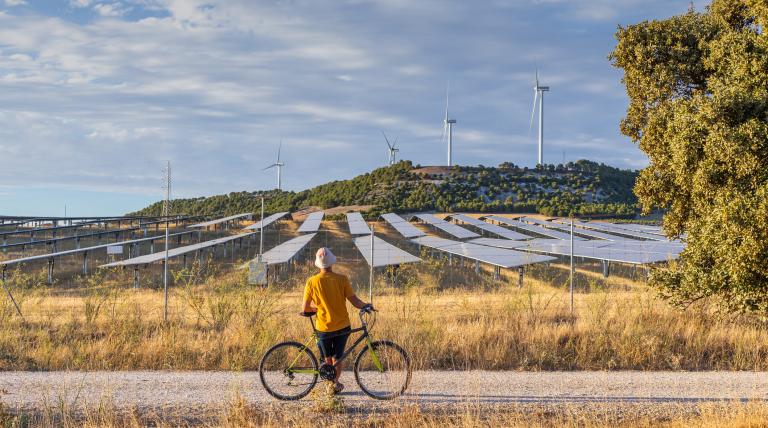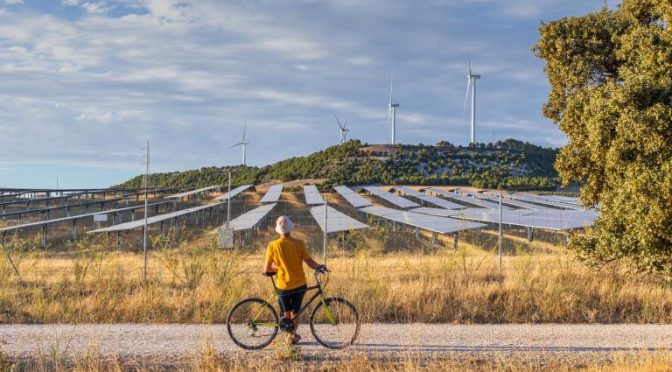Renewable energies could close the year representing more than 50% of the national mix, a historical maximum and almost nine percentage points higher than the 2022 quota.
Wind and solar photovoltaics complete an exceptional year, with respective records for production and participation in the generation structure.
According to estimates, 2023 is on track to be the year with the lowest CO2 equivalent emissions associated with electricity generation.
Renewable energies could close 2023 with a contribution to the national generation mix of more than 50% (50.8%), thus registering a historical maximum of production (more than 135,000 GWh). This is clear from Red Eléctrica’s estimates, which, like every year, advance the main magnitudes of the system that are prepared from preliminary data as of December 14.
For Beatriz Corredor, president of Redeia, parent company of Red Eléctrica, “these figures are irrefutable proof that the ecological transition is advancing steadily in our country. We have become a true European benchmark in the integration of renewables: we are the second country that generates the most wind and solar energy. But we must continue working to meet the objectives set for 2030.”
In the renewable energy sector, in 2023 the contribution of wind and solar photovoltaics has been especially significant. According to estimates, both technologies are going to close another exceptional year since they are expected to exceed their maximums in both production and participation in the national mix.
Wind power would hold the leadership of the generation structure, recording a share of almost 24% and a record close to 63,700 GWh. For its part, photovoltaics would be in fourth place in the mix with 14% and its production would exceed 37,000 GWh, almost 34% more than in fiscal year 2022.
The first positions in the generation structure would be completed by nuclear – in second position with 20% – and the combined cycle – third in the ranking with 17% -, technologies that experience a decrease in their production in 2023. In fifth position hydraulics would be located (9.5% of the mix) which, thanks to the increase in rainfall, would reach 25,500 GWh. This is a figure higher than that recorded in 2022 since it was a particularly dry year, a circumstance that led to the lowest hydraulic production since records began.
Thanks to the renewable contribution, this year will end as the one with the lowest CO2 equivalent emissions derived from electricity production. The forecasts point to a figure of less than 32 million tCO2 equivalent, which would mean a decrease of over 28% compared to 2022. This figure would mean that emission-free production reaches 72% of all generation.

A year that has surpassed all records
In 2023, the “record” concept has been permanently linked to renewable energies, because they have broken all their records. In this sense, and taking into account Red Eléctrica’s records, January was the most renewable month in history, in which the most GWh of renewable origin was produced, up to a total of 13,542 GWh. For its part, the recent month of November has been the one with the highest share of these technologies in the mix (59.6%). Finally, November 3 was a historical maximum for daily renewable participation (73.5%).
On the other hand, throughout this year other significant daily records have been recorded: on November 11, the share of emissions-free electricity production (87.9%); on October 26, daily wind generation quota (53.8%); and on June 10, photovoltaic production quota (22.4%).
Other magnitudes: demand and international exchanges
For its part, the demand for electrical energy would experience a decrease of 2.1% in 2023 compared to last year, once the effects of work and temperatures are taken into account. In gross terms, demand could be around 244,000 GWh, 2.6% less than in 2022, according to preliminary data from Red Eléctrica.
By system, electricity demand in gross terms will decrease by 2.8% in the peninsular electricity system, while in the Balearic Islands it will decrease by 0.9%. For its part, demand will increase in the Canary Islands by 2.8% compared to 2022.
The moment of greatest demand in the peninsular electrical system was recorded this year in winter, specifically on January 24 at 8:43 p.m. with a peak of 39,101 MW. This is a figure slightly higher than the previous year, reached on July 14, 2022 at 2:19 p.m. (38,284 MW).
On the other hand, for the second consecutive year, the Spanish electricity system is expected to close the year with an export balance close to 15,000 GWh, due to its international exchanges, mainly with France and Portugal.


